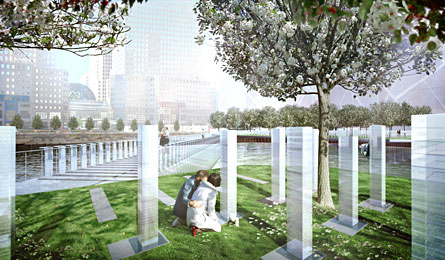| Suspending
Memory
By Joseph Karadin with Hsin-Yi Wu

Click these thumbnails for enlarged views of the Suspending
Memory proposal. • • • • • • • • • • • • • • •
This design covers the memorial site with
a pool. Two islands are located where the Twin towers stood.
Trees and glass columns
are spread across the islands, which are connected by a bridge
of stone and glass.
Each glass column is different, giving
a biography of the victim it represents. The columns are
lit at night.
A stone wall on the northern island contains
2982 polished squares, and separates the island from
its surroundings. Water descends from each square into
a reflecting pool.
Joseph Karadin moved to New York City in
1997, and works as a designer in Manhattan. Hsin-Yi Wu
was born in Taiwan, and moved to the United States in 1992.
Both studied architecture at Cornell University.
• • • • • • • • • • • • • • •
Finalist Statement
"The memorial at the World Trade Center site gives the victim's family
members a chance to tell the story of the ones that they
have lost. It will give each and every person who witnesses
the memorial a chance to
learn something about the people who perished and the family
members who continue mourn the loss of their loved ones.
The lives lost
on September 11, 2001 and February 26, 1993
collectively form the foundation of two memorial gardens
rising from where the WTC towers once stood. Each victim
is manifested as a symbol
of strength, a single column helping support one of two
island gardens. As the columns extend through the garden surface at varied
heights
they
transform from concrete into glass. Each unique glass column
is a timeline of a victim's defining moments beginning
with a birth date and culminating
at September 11, 2001 and February 26, 1993. It is an object
biography that gives visitors a glimpse of the persons
who perished on both days.
By sharing the victim's birth date and life story, it enables
visitors to relate and form a personal bond which otherwise
would not have existed.
The memorial column becomes a glowing beacon of each victim;
their defining moments shining brightest at night.
In passing between the ever-changing gardens, the visitor
is made aware of two other tragic events bridged in time;
Somerset County, Pennsylvania and Arlington, Virginia.
The memorial bridge is composed
of alternating bands of stone and glass, epitomizing the
past and the present, the enduring and the ever changing.
The name of each victim
from Pennsylvania and Virginia is etched into a glass plaque
suspended over a pool of reflected azure.
Upon entering
the North garden, visitors are greeted with a natural stone
wall inlaid with 2982 randomly protruding
polished squares. This wall spans the length of the island,
shielding it from its frenetic
surroundings. Water trickles from an opening at the base
of each square into a pristine reflecting pool. The Pool
of Tears enfolds the entire
memorial site forever preserving Ground Zero as hallowed
ground. The expanse of this pool is a metaphor of the
collective tears shed by millions
around the world.
The memorials become the embodiment
of each victim representing them as a summation of time;
a collection of moments
recorded in each life. Together they form a place of
hope and tranquil beauty
suspended
in a sea of calming motion."
Back to the main page
|